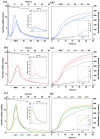Optimized Mortar Formulations for 3D Printing: A Rheological Study of Cementitious Pastes Incorporating Potassium-Rich Biomass Fly Ash Wastes
- PMID: 40805442
- PMCID: PMC12348173
- DOI: 10.3390/ma18153564
Optimized Mortar Formulations for 3D Printing: A Rheological Study of Cementitious Pastes Incorporating Potassium-Rich Biomass Fly Ash Wastes
Abstract
The use of 3D printing holds significant promise to transform the construction industry by enabling automation and customization, although key challenges remain-particularly the control of fresh-state rheology. This study presents a novel formulation that combines potassium-rich biomass fly ash (BFAK) with an air-entraining plasticizer (APA) to optimize the rheological behavior, hydration kinetics, and structural performance of mortars tailored for extrusion-based 3D printing. The results demonstrate that BFAK enhances the yield stress and thixotropy increases, contributing to improved structural stability after extrusion. In parallel, the APA adjusts the viscosity and facilitates material flow through the nozzle. Isothermal calorimetry reveals that BFAK modifies the hydration kinetics, increasing the intensity and delaying the occurrence of the main hydration peak due to the formation of secondary sulfate phases such as Aphthitalite [(K3Na(SO4)2)]. This behavior leads to an extended setting time, which can be modulated by APA to ensure a controlled processing window. Flowability tests show that BFAK reduces the spread diameter, improving cohesion without causing excessive dispersion. Calibration cylinder tests confirm that the formulation with 1.5% APA and 2% BFAK achieves the maximum printable height (35 cm), reflecting superior buildability and load-bearing capacity. These findings underscore the novelty of combining BFAK and APA as a strategy to overcome current rheological limitations in digital construction. The synergistic effect between both additives provides tailored fresh-state properties and structural reliability, advancing the development of a sustainable SMC and printable cementitious materials.
Keywords: 3D printing; biomass fly ash; cementitious material; circular economy; rheology.
Conflict of interest statement
Author Raúl Vico Lujano and Pilar Hidalgo Torrano were employed by the company Cementos La Cruz. The remaining authors declare that the research was conducted in the absence of any commercial or financial relationships that could be construed as a potential conflict of interest.
Figures












References
-
- Bravo M., Silva R.V., Duarte A.P., editors. Recycled Aggregate Concrete and Alternative Binders for Sustainable Building Engineering (Second Volume) MDPI; Basel, Switzerland: 2024.
-
- Ahmad M.R., Fernàndez-Jimenez A., Chen B., Leng Z., Dai J.G. Low-carbon cementitious materials: Scale-up potential, environmental impact and barriers. Constr. Build. Mater. 2024;455:139087. doi: 10.1016/j.conbuildmat.2024.139087. - DOI
-
- Petek Gursel A., Masanet E., Horvath A., Stadel A. Life-cycle inventory analysis of concrete production: A critical review. Cem. Concr. Compos. 2014;51:38–48. doi: 10.1016/j.cemconcomp.2014.03.005. - DOI
-
- Mohamad N., Muthusamy K., Embong R., Kusbiantoro A., Hashim M.H. Environmental impact of cement production and Solutions: A review. Mater. Today Proc. 2022;48:741–746. doi: 10.1016/j.matpr.2021.02.212. - DOI
-
- Buswell R., Leal de Silva W., Jones S., Dirrenberger J. 3D printing using concrete extrusion: A roadmap for research. Cem. Concr. Res. 2018;112:37–49. doi: 10.1016/j.cemconres.2018.05.006. - DOI
Grants and funding
LinkOut - more resources
Full Text Sources
Research Materials
Miscellaneous

